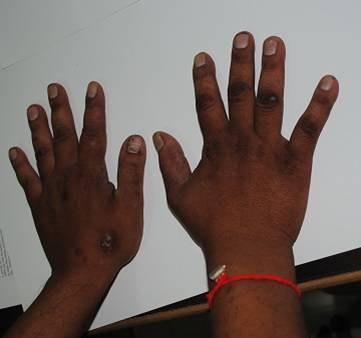Working Time
- Mon-Sat 09:00AM - 09:00PM
Sunday - Closed
Contact Info
-
Phone: 04040101539
9059600930
Cushing’s
What is Cushing’s syndrome?
Cushing’s syndrome consists of the physical and mental changes that result from having too
much cortisol in the blood for a long period of time. Cortisol is a steroid hormone produced
by the Adrenal glands, located above the kidneys.
When produced in normal amounts, Cortisol helps the body to
- Respond to stress
- Maintain blood pressure and cardiovascular function
- Keep the immune system in check
- Convert fat, carbohydrates, and proteins into energy
What are the types of Cushing’s syndrome?
There are two types of Cushing’s syndrome
- exogenous (caused by factors outside the body) and
- endogenous (caused by factors within the body).
What are the signs and symptoms of Cushing’s syndrome?
- Weight gain, especially in the central body
- Rounded face and extra fat on the upper back and above the collar bones
- High blood sugar (diabetes)
- High blood pressure (hypertension)
- Thin bones (osteoporosis)
- Muscle loss and weakness
- Thin, fragile skin that bruises easily
- Purple-red stretch marks (usually over the abdomen and under the arms)
- Depression and difficulties thinking clearly
- Too much facial hair in women
What is Exogenous Cushing’s ?
The most common is exogenous Cushing’s syndrome and is found in people taking CORTISOL-like medications such as prednisolone (Wysolone) or Dexamethasone. These drugs are used to treat inflammatory disorders such as asthma and rheumatoid arthritis. They also suppress the immune system after an organ transplant. This type of Cushing’s is temporary and goes away after the patient has finished taking the cortisol-like medications.
What is Endogenous Cushing’s?
Endogenous Cushing’s syndrome, in which the adrenal glands produce too much cortisol, is uncommon. It usually comes on slowly and can be difficult to diagnose. This type of Cushing’s is most often caused by hormone-secreting tumors of the adrenal glands or the pituitary, a gland located at the base of the brain. In the adrenal glands, the tumor (usually non-cancerous) produces too much cortisol. In the pituitary, the tumor produces too much ACTH—the hormone that tells the adrenal glands to make cortisol. When the tumors form in the pituitary, the condition is often called Cushing’s disease. Most tumors that produce ACTH originate in the pituitary but sometimes non-pituitary tumors, usually in the lungs, can also produce too much ACTH and cause Cushing’s syndrome.
How is Cushing’s syndrome diagnosed?
Three tests are commonly used to diagnose Cushing’s syndrome.
- screening test : people with suspected Cushing’s syndrome have their cortisol levels measured the morning after taking a late-night dose of dexamethasone, a laboratory-made steroid. Normally, dexamethasone cause cortisol to drop to a very low level, but in people with Cushing’s syndrome, this doesn’t happen
- One of the most sensitive tests measures cortisol levels in thesaliva between 11:00 p.m. and midnight. A sample of saliva is collected in a small plastic container and sent to the laboratory for analysis. In healthy people, cortisol levels are very low during this period of time. In contrast, people with Cushing’s syndrome have high levels
- Cortisol levels can also be measured in urine that has been collected over a 24-hour period.
How is Cushing’s syndrome treated?
The treatment for Cushing’s syndrome depends on the cause. Exogenous Cushing’s syndrome goes away after patients finish taking the cortisol-like medications they were using to treat another condition. Your doctor will determine when it is appropriate for you to slowly decrease and eventually stop using the medication. For Endogenous Cushing’s syndrome, the initial approach is almost always surgery to remove the tumor that is causing high cortisol levels. Although surgery is usually successful, some people may also need medications that lower cortisol or radiation therapy to destroy remaining tumor cells. Some people must have both adrenal glands removed to control Cushing’s syndrome.
CUSHING'S CASES TRATED AT AED

Fig: 1- Description: Darkening Skin ( Change in Complexion ) Especially on healed injury sites.

Fig: 2-Description:
- Weight gain, especially in the central body
- Muscle loss and weakness
- Thin, fragile skin that bruises easily
- Purple-red stretch marks (usually over the abdomen and under the arms)
- Rounded face and extra fat on the upper back and above the collar bones
- Thin bones (osteoporosis)
- Enlarged Breasts (chest)

Fig: 3- Description
- Depression and difficulties in thinking clearly.
- Rounded face and extra fat on the upper back and above the collar bones.
- Darkening Skin ( Color change from white to Brown), pigmented Skin
 NABH ACCREDITED
NABH ACCREDITED


